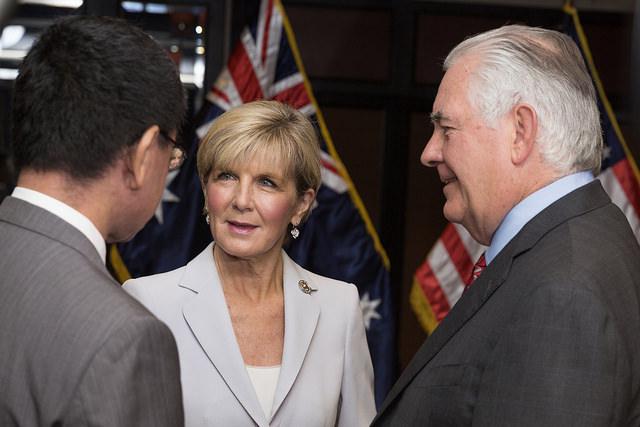The future of the US–Australia alliance
Posted By Charles Edel on July 3, 2018 @ 14:56

Some have argued that the US–Australia alliance exists simply out of inertia or, worse yet, sentimentality. Shared sacrifice and longstanding habits of cooperation may play a role, but they’re not the basis upon which sovereign states determine their national interests.
The value of the alliance is its preservation of something that may seem intangible, and yet nevertheless is essential to the security, prosperity and values of both of our nations: support for a rules-based order. Without a doubt that sounds abstract, and can present a challenge to its defenders. But a rules-based order means that it is not simple raw power that determines outcomes.
Rules as the basis for order, backed by the power of the US and its partners to promote the rules, have delivered tangible benefits that bear repeating: preventing a great-power war; promoting an open and prosperous global economy; advancing democracy and human rights; and fighting to protect a system where rules are respected, territorial integrity preserved, and political independence maintained. These goals can only be achieved with strong alliances.
Given the intensifying challenges that various authoritarian regimes are putting on the international order created by America and its friends, and the shocks generated by Donald Trump, it will take working in concert with other like-minded states to defend and renew the rules and behaviours that will ensure our future prosperity and security.
I would suggest three specific ideas for refocusing the alliance. This will require reorienting the alliance’s geographic focus while broadening its scope beyond security, and expanding the joint efforts globally.
Geographically, a shift in focus to Asia is overdue. China’s rise to power is upending decades of relative stability in the region. While China’s rise has been beneficial in many ways, Beijing’s increasingly assertive military operations, use of various forms of economic coercion and attempts to intervene in other countries’ domestic affairs—and the challenges to the rules-based order that propelled China’s rise in the first place—have heightened regional concerns.
There’s much that Australia and America, in partnership and focused on the Asia–Pacific, can do to help stabilise the region. In the Pacific part of the Asia–Pacific, both countries can increase their efforts to promote sustainable development in the Pacific island states.
In the Indian Ocean part of the Indo-Pacific, there’s more they can do to partner with and encourage a rising India. And, perhaps most acutely in Southeast Asia—a region likely to become one of the world’s largest drivers of growth over the next several decades—there’s much that can be done to facilitate growth, promote sustainable development, and shore up sovereignty. Aligning Australian and American strategies in these sub-regions will likely amplify the individual efforts of each country.
Just as the geographic focus needs to move to Asia, the scope of the alliance needs to move beyond security. Without a shift, both Australia and the US are likely to harden the mistaken perception that nations must choose between their economic and security interests.
In support of the region’s vision of an open and integrated economic community, Canberra and Washington can help unlock access to private capital and investment, facilitate trade into and between the nations of Southeast Asia, and promote public–private partnerships that can underwrite physical and digital infrastructure projects. Doing so is likely to advance sustainable development in this dynamic region, contribute to transparency and the rule of law, raise environmental and labour standards, and provide better market access for Australian and American businesses.
Critically, such efforts would strengthen the resilience of institutions—political, economic and civil society. Both governments have efforts underway in this area. Thinking through how their economic and financial assets can augment each other, where to prioritise their efforts, and how best to deconflict resource allocation is the logical next step.
A final idea is to think globally—in a strategic and collaborative manner. This means seeking out more coalitions of the willing, drawn from the Atlantic, Indian and Pacific ocean regions, who see a need, have the will and possess the capabilities that can sustain an open and free order.
On the face of it, this suggestion seemingly cuts against the idea that the Australian–American alliance needs to narrow its geographic focus. But multiple regions of the world have a stake in underwriting a stable and prosperous Asia. Australia and America, perhaps in concert with Japan, can do much to draw other nations into their efforts and harness their strengths. This is not to suggest that this would be an alliance in the near term, but rather an effort to work more regularly with other like-minded states.
The immediate challenge will be that Washington isn’t currently providing leadership and stability in these areas as it has done in the past. And yet, despite the temptation to seek distance from a White House that radiates instability, the impulse of America’s allies should be the exact opposite. This is even more crucial in light of the actions being taken by authoritarian powers, bent on carving out their own spheres of influence in which to exercise diplomatic, economic and military primacy.
If there is concern that the White House has stepped back from its role as guarantor of the postwar order, and if allied nations believe that this order, for all its flaws, is still in their interests, they must step up to the defence of it—to Washington and to others.
Article printed from The Strategist: https://aspistrategist.ru
URL to article: /the-future-of-the-us-australia-alliance/
Click here to print.